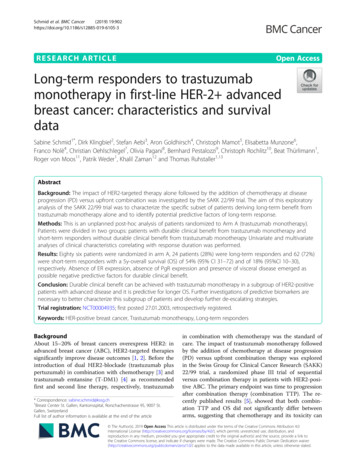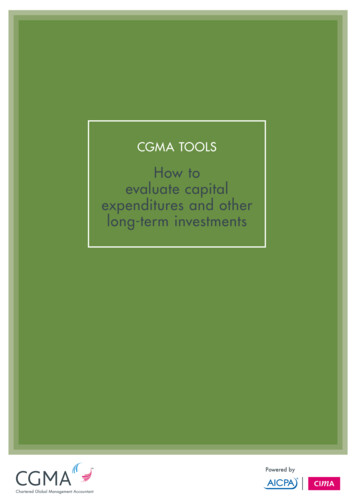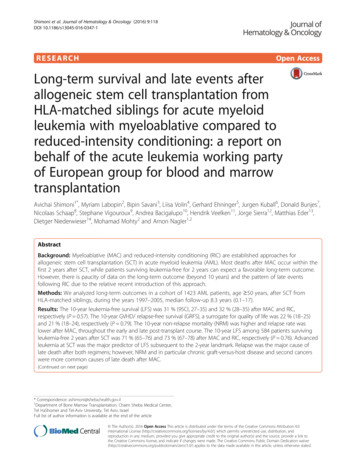
Transcription
Understanding and ManagingLong-term PainInformation for People in Pain
Understanding and ManagingLong-term PainInformation for People in PainPublished by:The British Pain Society3rd Floor, Churchill House, 35 Red Lion SquareLondon WC1R 4SGWebsite: www.britishpainsociety.orgISBN: 978-0-9561 386-8-2 The British Pain Society 2015(review date 2018)No part of this publication may be reproduced, stored in aretrieval system or transmitted in any form or by any means,without the prior permission, in writing, ofThe British Pain Society.
ContentsPageWhy you should read this booklet4Why doesn't my pain go away?5What might this mean for me?8What help is available?10Who can help me and what might they do?10What treatments might be offered?14 Exercise15 Manual therapy17 TENS18 Acupuncture18 Drugs (medicines)19 Injections26 Long-term devices27What can I do to help myself?28What is a pain-management programme?34Summary36More information and support for patients and carers37
Understanding and Managing Long –term PainWhy you should read this bookletWe all know what pain is. We have all suffered from it. Sometimeswe hardly notice it. Sometimes it may be unbearable. Usually itgoes away on its own but, at other times, it may need treatment.Unfortunately, there are times when it doesn’t go away at all, becominglong-term pain. (Health professionals often use the terms ‘chronic pain’or ‘persistent pain’.)Not for reproductionThere are many different causes oflong-term pain and we do notknow them all yet. The aim of thisbooklet is to help you make senseof long-term pain, understand thedifficulties associated with it andhow it can best be managed. Wedo not specifically cover paincaused by cancer, but much of whatis described can also apply tocancer pain.Not for reproductionNotfor reproductionWhether your pain is recent orlong -term, severe or less severe,this booklet explores the best waysof managing it. We look at whatpain is, what can be done about it,who can help you with it and howyou can help yourself.Not for reproductionThe aim of this booklet is to help you understandthe difficulties associated with long-term painand how it can best be managed.4
Information for People in PainWhy doesn’t my pain go away ?Some pain is easy to understand because there is an obvious injurysuch as a cut or a bruise. Other pains are less obvious. For example,you cannot see the pain of appendicitis, but anyone who has had it willtell you that it is real enough.Not for reproductionHealth professionals use different terms for different types of pain. Short-term pain, such as when you suffer a sprained ankle, is called'acute' pain. Long-term pain, such as back pain that persists for months or years,is called 'chronic' pain.that comes andgoes, like a headache, is called ‘recurrent’ pain.NotPainforreproduction It is not unusual to have more than one sort of pain or to have pain inseveral placesPain is defined by the International Association for the Study ofPain (IASP) as “an unpleasant sensory and emotional experienceassociated with actual or potential tissue damage, or described interms of such damage” (www.iasp-pain.org).Not for reproductionThe definition is important because it links emotion and pastexperience to the sensory event. This means that the only wayof deciding whether someone has pain is by asking them orpicking up clues from the way they behave.Many acute pains are a useful alarm signal that something is wrong. Mostminor pains get better on their own or with simple treatment. Othersmay be a sign of something more serious, as with a broken leg. This painis helpful because it means that you get treatment and rest your leg untilthe break has had a chance to heal. Long-term pain, on the other hand,appears to serve no useful purpose and has a huge impact on the lives ofmany people.Not for reproduction5
Understanding and Managing Long –term PainWhy doesn't my pain go away?Pain can be experienced in any part of your body and involve a numberof different mechanisms: The pain most commonly felt when pain mechanisms are ‘switchedon’ is technically known as ‘nociceptive pain’. When body tissues are injured, inflammatory changes can occurleading to ‘inflammatory pain’. If sensory nerves are damaged and malfunction the result is nervepain or ‘neuropathic pain’. When our internal organs are affected we may experience ‘visceralpain’. It is possible to have pains involving more than one mechanism.These are referred to as ‘mixed pains’.Not for reproductionNot for reproductionNormally, when we feel pain, signals travelfrom part of the body alongparticular nerve fibres via the spinal cordto the brain. However, in some cases (forexample, pain after a stroke) damage tothe brain or to the spinal cord can causepain to be felt in parts of the body whichare not actually damaged. This type ofneuropathic pain (see above) can belikened to a faulty burglar alarm—thealarm is sounding but there is no intruder.Not for reproductionPain signals are initially processed in thespinal cord and then in the brain wherethere are connections with centres associated with anxiety, emotions,sleep, appetite and memory. This creates a very personal experience ofpain for each person.Not for reproductionThe brain sends signals back to the spinal cord which can, in turn, reduceor increase the pain further. Nerve endings and parts of the spinal cordand brain can become over-sensitised as a result of constant pain input.6
Information for People in PainWhy doesn't my pain go away?One reason is a process called ‘central sensitization’. This is a type of‘learning’ by nerve cells in your spinal cord and brain which means thatthat the pain does not go away even if the original cause is discoveredand treated. It may result in pain experience that seems out ofproportion to the initial injury.Not for reproductionIn simple terms the body’s warning system becomes more sensitive,producing an increased feeling of pain even though there may no longerbe any continuing damage to the body. This can lead to a long-term andchallenging problem. You and the healthcare professionals need to worktogether with skill, time and patience to improve things.Althoughformedical technologyis improving all the time, some pain is veryNotreproductioncomplicated. It may involve so many factors that we may never be ableto find the precise cause with X-rays, scans or laboratory tests.However, not knowing the cause of the pain does not mean it does notexist and the problems it creates are also very real.Only the person in pain can really say how painful something is. Becausepain is always personal, no two people experience it the same way. Thiscan make it very difficult to define and to treat.Notfor reproductionUnfortunately, there is more to long-term pain than simply hurting. Thisis unpleasant enough by itself, but when it continues for a long time itcan affect every part of your life and how you cope with it. It may affectyour ability to work, your relationships with family and friends, youractivity levels and your sleep. All of this may become overwhelming attimes and can cause a vicious circle of increasing pain and distress.Not for reproductionPain is never ‘just in the mind’ or ‘just in the body’.It is a complicated mixture of signals from the bodyand how the brain interprets them. You know yourpain, even though it cannot be seen. The challengefor you and those treating you is to understand thecomplicated nature of long-term pain and the bestway to manage it.7
Understanding and Managing Long –term PainWhat might this mean for me?Long-term pain is complicated and not easily ‘fixed’. You will needpatience to work alongside your health professionals to work outwhat works best for you.Notfor reproductionUnfortunately, you may have to continue to live with some level of painbecause there may not be a way to get rid of it. However, this does notnecessarily mean that it will get worse or that continuing damage is beingdone. This is why health professionals often refer to pain managementrather than talking about treatment or cure.You should ask the health-care professionals who are helping you toexplain— so far as they understand—the things that puzzle, concern orworry you.Not for reproductionCommon questions are: What is causing my pain? Is it likely to get worse? What are the investigations (X-rays, scans and so on) lookingfor, and what do my results mean?NotIf myforreproductionpain medicinesdon't work, can I have stronger ones or what else can be done? If a pain medicine does work, will it hide other pains whichmight be telling me that something else is wrong and needsattention? Why can't my pain be switched off?Not for reproduction Could a surgeon see something if he or she looked inside me,even if it doesn’t show on a scan? If I take morphine or other similar drugs for my pain, will I getaddicted? What are the side effects of the drugs I am taking? What is the effect on my body of taking drugs for a long time?8
Information for People in PainWhat might this mean for me?It will help those looking after you if you can give them the answers tothe following questions:What makes the pain worse? Is this straight away or after aNot forreproductionwhile? What eases the pain, even a little? What does the pain stop you doing? What can you still do, but avoid doing because it hurts? What don't you do because you are worried you mightdamage yourself?Not forreproductionDoes the painstop you getting to sleep? Does the pain wake you up? Does your mood or stress affect your pain? Does your pain affect your mood or stress levels? If you are taking a pain medicine, how well does it reducethe pain and for how long?To find thebest treatmentsfor you, it is often necessary to try variousNotforreproductionoptions to see if they help. This is not because the health-careprofessionals do not know what they are doing, but because pain iscomplicated and every pain and every person is different.Not for reproduction9
Understanding and Managing Long –term PainWhat help is available?Who can help me and what might they do?here is a lot that can be done to help you. The best results comeNotreproductionplay an active role in treating your condition alongsideTwhen youforthose who are treating you. How you can help yourself is covered in thenext chapter of this booklet.While your GP may be able to helpwith your pain by prescribingmedicine, for some patients a morespecialist approach may be needed.Help in managing long-term paincan come from a variety ofhealthcare professionals. Mostpatients will meet these peoplethrough the National HealthService (NHS) after being referred by their GP, although some servicescan be accessed privately.Not for reproductionYou will find the health-care professionals with most experience ofNotformanaging long-termpain in reproductionspecialist pain clinics in hospitals. However,the NHS is changing and more specialist services are now availableoutside these clinics and even outside the hospitals.Pain clinics are often 'multi-disciplinary', which means you may be seenby a number of specialists – for example, doctors, nurses,physiotherapists, psychologists and occupational therapists. Each has adifferent part to play in managing your pain though their roles oftenoverlap.Not for reproductioncan normally be found in pain clinics. TheySPECIALIST PAIN DOCTORSare usually anaesthetists who have undergone specialist training in painmedicine. They are likely to play a key role in relation to diagnosticquestions and in advising on and delivering medical and interventionaltreatments.10
Information for People in PainWhat help is available?You may not always see a doctor on your first visit to the clinic. Anothermember of the team may see you first. The healthcare professional whoassesses you will listen to your story and ask questions to piece togethera picture of your pain, how it is linked to other medical problems thatyou might have and how it affects you as a person.Not for reproductionThis is called an ‘holistic assessment’ and is a very important part ofunderstanding your pain and the impact it is having. Your answers andyour own thoughts and views are an important part of the assessment.Sometimes you will be asked to fill in a questionnaire about your painand how it is impacting on you and your life. It can be helpful to takealong a list of your current medicines as well.Not for reproductionNot for reproductionPainmeasurementis one part ofan holisticassessmentThe assessing clinician will talk with you about the types ofpain that you have and will try to explain why this has happened. He orshe may also examine you to look for any causes for the pain that mighthave been missed and to assess your overall state of health. Then theywill discuss a management plan with you. Sometimes this may be afteryou have seen other members of the pain team.Not for reproductionYou may be prescribed drugs that are unusual or new to you. Your GPmay also be unfamiliar with these. The pain clinic may also use injectionsor other pain-relieving procedures, often requiring X-rays and specialistequipment. They may well offer more than one treatment.11
Understanding and Managing Long –term PainWhat help is available?It is possible that you may need more specialist investigations (such as anMRI scan) than your GP can arrange. It is possible too that the painspecialist may decide you need to be referred to another hospitalconsultant: for example, a rheumatologist, neurologist or surgeon.Not for reproductionYou may be asked to see a pain psychologist as part of the teamassessment. This does not mean that the professionals advising youthink you are imagining your pain or that you are 'mad' - far from it.can be very helpful in looking at ways to help youmanage your pain so you can live a more normal life. This usuallyinvolves a discussion of how you understand your pain, how you feelabout it and what you think willhappen in the future. This is becausethis is what guides you in your dayto-day life.PSYCHOLOGISTSNot for reproductionTrying different ways of seeing thingsand different ways of doing thingscan help when you cannot see a wayforward. Psychologists might alsoidentify other stresses that areadding to your pain.Not for reproductionare important in a pain team because pain canimpact on your ability to move normally. Although physiotherapyservices for pain are usually based in physiotherapy departments in largehospitals, they are becoming more available in GP surgeries and healthcentres.PHYSIOTHERAPISTSNotfor reproductionPhysiotherapists may use a variety of approaches for long-term pain. Inthe early stages you may be offered treatments to try to relieve yourpain. This could include manual therapy, electrotherapy or acupuncture.In a pain clinic, however, you are more likely to be given information andadvice to help you to lead an active life and maintain your quality of life.12
Information for People in PainWhat help is available?Pain may increase when you first try new exercises. This is normal butdo tell the physiotherapist or doctor if the flare up in your pain is moresignificant. The exercises may need to be adapted. Additional pain reliefmay also be required.Not for reproductionOCCUPATIONAL THERAPISTS (OTs)can also be found in some painteams. Their roles may overlap with others such as the physiotherapistor psychologist. They can often give expert advice on how you can bestmanage your day-to-day activities despite your pain. They may alsoassess you, your home and your workplace to identify helpfuladjustmentsare normally employed in the NHS in painNotforreproductionclinics, with some working in the community. The role of the specialistSPECIALIST PAIN NURSESpain nurse varies from place to place. They are normally involved inproviding information and advice, often helping with trials of painmedicines. They may also offer treatments such as acupuncture or TENS(see page 18).are experts in medicines. If youhave not fully understood or remembered all thedetails of how to take your medicines, yourpharmacist will help explain this to you.PHARMACISTSNot for reproductionCHIROPRACTORS AND OSTEOPATHS mainlyuse manual therapies such as manipulation andmassage to treat pain. This treatment is notnormally available as an NHS treatment.In spite of the huge progress that modernmedicine has made, pain specialists cannot cureor relieve all pain. But they can make a realimprovement to the quality of your life byinvolving all the members of the pain team in a many-pronged (multidisciplinary) approach. You may be offered the chance to join astructured pain management programme (PMP) to make best use of thisapproach (see page 34).Not for reproduction13
Understanding and Managing Long –term PainWhat help is available?What treatments might be offered?It is not uncommon to hear people with long-term pain conditions sayNotfor reproductionthat they are prepared to try anything to be free from pain. Even if youhave never said this yourself, you will probably understand those whodo. In searching for effective treatments, however, you may come acrossmany types of treatment that have no scientific evidence. They may helpbut they could harm. It is possible to spend a lot of money on treatmentsthat are not proven to work and which could possibly make mattersworse.Most treatmentsoffered toreproductionyou by pain clinics will have undergone anNotforassessment process through formal research or by examining outcomesof treatment in other patients with similar problems. Healthcareprofessionals use this knowledge to advise you as to which treatment orcombination of treatments is likely to help. This is called evidence-basedmedicine.Before starting any treatment, itis worth asking about thepossible benefits as well as anyrisks. You may also ask theclinician how the treatmentworks, how long it will take andhow much it will cost (if it is notavailable on the NHS). You mayalso like to make sure that thetherapist is registered with areputable professionalorganisation.Not for reproductionTreatments Exercise Manual Therapy TENS Acupuncture DrugsSide effectsStandard pain medicinesStronger pain medicinesNot for reproductionDo not feel you have to acceptany treatment or continue with itif you do not wish to.Combination pain medicinesNon-standard medicines for pain Topical medicines Injections Long Term Devices14
Information for People in PainWhat help is available? Exercise (or being active)For many people with long-term pain, exercise is a word that strikesthem with fear. Their previous experience of exercise has often beenpainful and some may believe that movement will cause damage. It is understandable that many are reluctant to try it. A physiotherapist is likelyto be able to help you learn safe and effective exercises for your specificcondition.Not for reproductionThere is a difference between exercise that would help you recoverfrom acute pain and exercise for long-term pain. Exercise for long-termpain is designed to help you best use and build on what you can do. Because of pain, you may be less active, and that can lead to stiff joints, increased weight, poor fitness, weak muscles and getting breathless moreeasily. In the long run, a lack of exercise can also lead to other healthproblems.Not for reproductionNot for reproductionNot for reproduction15
Understanding and Managing Long –term PainWhat help is available? Exercise (continued)People with long-term pain face a dilemma: activity may increase pain’especially at first, but a lack of activity is likely to lead to long-termproblems. This is particularly true for people who have joint painassociated with arthritis. These problems can then, in turn, cause anincrease in pain. However, exercise is vital to help deal with long-termpain and live a meaningful life.Not for reproductionFor any of us, getting started can be difficult. We all ache when we havenot exercised for a long time. This is a sign that the body is rebuildingmuscles and tendons, not a sign of damage. For people with long-termpain, however, these normal aches and pains can be more severe andmore challenging but they are still not a sign of damage. It pays to startgently and build up slowly. A physiotherapist can help you draw up aspecific activity and exercise regime that you are able to manage andlikely to stick to.Not for reproductionExercises can be divided intotwo types – general andspecific. General exercise, suchas walking, swimming, dancing,cycling and aerobics, improvesyour fitness and helps manageyour weight. Specific exercisesare performed to increase thestrength or movement ofparticular muscles or joints.Not for reproductionNotreproductionIt is importantforto find activitiesthat you enjoy. This might be going to thegym or it might be walking, cycling, dancing, doing tai chi or gardening.Exercise should become an enjoyable part of life rather than a chore. Ifyou can build it into a routine and do it with friends or family you aremuch more likely to keep it up.16
Information for People in PainWhat help is available? Manual TherapyManual therapy includes both mobilisation and manipulation and shouldbe performed by registered health professionals: physiotherapists,osteopaths or chiropractors.Not for reproductionMobilisation involves the therapist applying slow, passive movements to ajoint. The patient cannot perform these movements independently butthey are within the normal range of motion of the joint.Manipulation is also a passive technique where the therapist applies aspecifically directed manual thrust to a joint, at or near the end of thenormal range of motion. This may be accompanied by an audible ‘crack’or ‘pop’.Not for reproductionBoth of these can help to improve the range of movement of a jointwhich may lead to short term pain relief allowing increased exercise andactivity. However, if you have enhanced pain sensitivity (sensitisation),often found in long-term pain conditions, manual therapies may actuallyaggravate your pain.Massage foris a gentle, oftenrelaxing, hands-on treatment which can helpNotreproductionmuscles relax and it may distract you from the pain. The benefits of amassage are likely to be short term, but it could help you get over adifficult period. If your pain condition has been previously assessed by anappropriate doctor or health professional, massage is unlikely to causeany harm.Registered health professionals may offer massage, but many othertherapists and individuals also offer massage therapies. If you are seekingtherapy outside of the NHS, it is advisable that you check that yourtherapist is appropriately trained. If in doubt, you should seek advicefrom your doctor or physiotherapist.Not for reproduction17
Understanding and Managing Long –term PainWhat help is available? TENSTranscutaneous electrical nerve stimulation (TENS) aims to block, orpartially block, pain signals as they pass through the spinal cord on theway to the brain. It does this by passing amild electrical current through the skin viasticky pads. The sensation of vibrationproduced by the TENS machine makes itmore difficult for nerves in the spine to passpain messages up to the brain. It is a similaralthough more reliable way of reducing painby ‘rubbing it better’.Not for reproductionNot for reproductionA TENS machine is often available throughyour GP, pharmacy, physiotherapydepartment or pain clinic. They are notexpensive to buy from larger pharmacy stores. It is important to taketime to learn how to use TENS and you may wish to seek professionaladvice. Some people find it a useful alternative to taking medicines, whichdo not work for everyone or which may have side effects. Some peoplefind the benefit from TENS continues for as long as the device is used,others find it diminishes over time.Not for reproduction AcupunctureAcupuncture may be available in some GP surgeries, NHS pain clinicsand physiotherapy departments as well as fromprivate practitioners. The effect is very variablebetween patients and may depend on the type ofpain condition. The benefits are often short-termrather than long-lasting. You may need to have‘top-up’ treatments to maintain the benefits. Youshould check that your acupuncturist is trainedand registered with a recognised professionalorganisation – see More Information on page 37.Not for reproduction18
Information for People in PainWhat help is available? Medicines (drugs)‘Painkillers’ are probably the treatment that most people expect to begiven when they have pain. Many find, however, that ‘painkillers’ don’t‘kill’ the pain either in the short or long term. That can be disappointingand frustrating. You should discuss with your doctor what you expectfrom the treatment.Not for reproduction“Why don’t my pain medicineswork?” is a commonly askedquestion, and often one withoutsimple answers. Persistent paincan arise through several differentmechanisms, and most individualdrugs only work on onemechanism. Some pains do notseem to respond to any painrelieving drug. You can alsodevelop a tolerance to some painmedicines, so that you need moreand more to have the same effect.Not for reproductionNot for reproductionThe correct dose of any medicineis the minimum dose thatproduces the maximum benefit.Deciding whether to continuewith a drug depends on balancingthe benefits (in this case relief ofpain) against the drawbacks (for example, unpleasant side-effects).Not for reproductionIt is very helpful to keep a record of which medicines you have used, thedose, for how long, how you responded to it and why you stopped it.This can prevent you being prescribed the same drug a second time oralert the doctor to recommend changes to the way you use it.19
Understanding and Managing Long –term PainWhat help is available?SIDE EFFECTSAny medicine can have side effects or interact with other medicines youare taking. This will vary from one patient to another. Many side effectsreduce with time or can be treated effectively.Not for reproductionSome problems are common to many drugs, such as feeling sleepy,feeling dizzy, getting a rash or feeling sick. Other problems may be morespecific, such as indigestion from NSAIDs (non-steroidal antiinflammatory drugs), weight gain from anti-epileptics and constipationfrom opioids. Some medicines can be linked to more serious side effectssuch as bleeding of the stomach lining or breathlessness. This is whymany medicines are only available on prescription.Not for reproductionThe list of possible side-effects that are included on patient informationleaflets is often quite long but each side-effect will normally only apply toa few patients. You may be fortunate and have none of the side-effectsor you may be unfortunate and have a number of them. Similarly, if amedicine needs to be stopped, some people are able to do so easily withno withdrawal symptoms. Others, however, can find it difficult evenwhen cutting down slowly.Not for reproductionDecisions about pain medicines are important and, often, not simple andstraightforward. These decisions need to be shared, between you andyour doctor or prescriber.You are the only one whocan report on the benefitsand the side-effects.If you have concernsabout reproductionNotforthe side effects of yourmedicine, particularly whenyou start a new one, contactyour doctor or pharmacist assoon as possible.20
Information for People in PainWhat help is available?STANDARD PAIN MEDICINESWe are all familiar with using paracetamol for everyday aches and pains.Far from being just a weak pain medicine that can be bought frompharmacies or supermarkets, it can be very effective in controlling painfor many patients. Taken regularly in the short term and whenprescribed (usually one or two 500mg tablets four times a day), it is asafe and useful drug. However, as with other pain medicines, only take itif you are confident that it is contributing to your pain relief.Not for reproductionStandard Pain MedicinesNot for reproductionParacetamolNon-Steroidal Anti-Inflammatory Drugs b (called a Cox II inhibitor)Non-steroidal anti-inflammatory drugs (NSAIDs) are also widely used.NSAIDs such as aspirin, ibuprofen and naproxen are available without aprescription and some NSAIDs are available as creams or gels to rub onthe painful part, which is a very safe way of using them. When taken bymouth or as a suppository (inserted in the bottom), NSAIDs may helpwith joint and muscle pain. However, they do need to be used carefully –especially if you have had a stomach ulcer or asthma, heart, liver orkidney problems.Not for reproductionIn order to minimise the risk of serious side effects you should take theNotforreproductionlowest dosefor the shortesttime.It is important to be aware that you can get ‘overuse’ headaches fromtaking analgesics on a regular basis, particularly if you are a migrainesufferer. This includes over-the-counter medicines such as paracetamoland aspirin. Do discuss any concerns with your doctor.21
Understanding and Managing Long –term PainWhat help is available?STRONGER PAIN MEDICINESThese are normally drugs related to morphine and are, as a group,known as ‘opioids’. Many people are uneasy about taking medicines fromthis group and doctors only recommend them when other drugs or painrelief methods have proved inadequate. However, if you follow specialistadvice, you may find that the benefits are greater than any risks.Not for reproductionProblems can occur if you take more than the prescribed dose or if youuse the medicine to manage problems other than pain. An example mightbe taking strong opioids to reduce anxiety. If you have pain most of thetime, you are likely to be prescribed stronger pain medicines in a slowrelease form. This can help ensure that you have fewer ups and downs inyour pain.Not for reproductionThese medicines are commonly divided into weak and strong opioids. Codeine is the comm
Short-term pain, such as when you suffer a sprained ankle, is called 'acute' pain. Long-term pain, such as back pain that persists for months or years, is called 'chronic' pain. Pain that comes and goes, like a headache, is called ‘recurrent’ pain. It is not unusual to have more than one sort of pain










